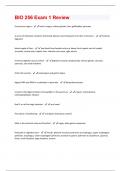BIO 256 Exam 1 Review 6 accessory organs - teeth, tongue, salivary glands, liver, gallbladder, pancreas A series of hydrolysis reactions that break dietary macromolecules into their monomers - chemical digestion blood supply of liver - oxy blood from hepatic artery or deoxy from hepatic vein to hepatic sinusoids, central vein, hepatic vein, infection vena cava, right atrium chemical digestion occurs where - digestive enzymes produced by salivary glands, stomach, pancreas, and small intestine chief cells secrete - pepsinogen and gastric lipase digests RNA and DNA in nucleotides in pancreas - deoxyribonuclease enzymes that digest proteins into peptides in the pancreas - trypsin, chymotrypsin, carboxypeptidase, elastase final 3 cm of the large intestine - anal canal first phase of swallowing - oral phase (voluntary control) folds in the stomach name and function - rugae; allow gastric expansion food path in digestive tract - mouth, pharynx muscles push bolus to esophagus, upper esophageal sphincter, esophagus, lower esophageal sphincter, stomach to pyloric sphincter to duodenum, jejunum, ileum, small intestine, large intestine, rectum four layers of the digestive tract - mucosa, submucosa, muscularis externa, serosa (from inner to outer) function of bile and where it is stored - contributes to digestion of fats, the gallbladder stores bile function of digestive system - processes food, extracts nutrients and eliminates residue function of myenteric plexus - controls peristalsis and other contractions of muscularis externa function of saliva - begins starch and fat digestion, inhibits bacterial growth, binds food together to form bolus, dissolves molecules to stimulate taste buds function of submucosal plexus - control glandular secretions of mucosa and movement of muscularis mucosae function of the esophagus - actively move food and liquid to stomach functions of colon in large intestine - drive contents into rectum, formation of feces, absorbs vitamins that are liberated by bacteria, convert proteins into amino acids, produce some B vitamins functions of liver - produce bile, processing of drugs and hormones, excretion of bilirubin, phagocytosis, vitamin D activation and synthesis of bile salts functions of small intestine - absorbs and digests 90% of nutrients and water functions of stomach - food storage, mechanical digestion, chemical digestion, production of chyme/intrinsic factor gastric lipase function - plays minor roll in lipid digestion, rest digested in small intestine




